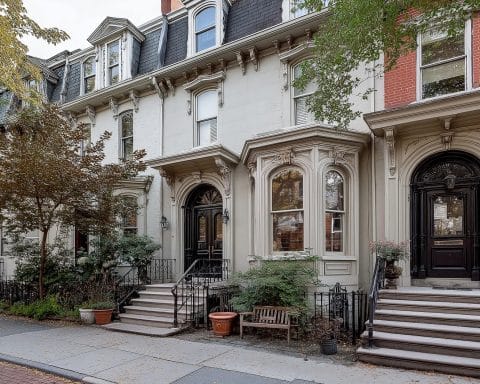Jersey’s real estate market has undergone a notable correction since peaking in late 2022. Amid rising interest rates and economic shifts, 2023 saw both property prices and transaction volumes decline sharply, but recent data from 2024–2025 indicate signs of stabilization. This report provides a comprehensive overview of Jersey’s property sector – spanning residential housing, commercial real estate, the rental market, and the luxury segment – as of 2025. We examine current trends (prices, demand, supply), recent market performance, and policy developments shaping the sector, and we include expert forecasts for the short to medium term (through 2028) to guide investors, homebuyers, and policymakers in decision-making.
Residential Property Market
Market Trends and Prices: Jersey’s house prices have cooled significantly from their 2022 highs. In Q1 2025 the mix-adjusted average price of dwellings was about 3% lower year-on-year and fully 14% below the peak reached in Q3 2022 stats.je. This downturn made 2024 the worst year for house prices on record (since at least 1986) with an 8% drop compared to 2023 stats.je – the largest annual fall in ~38 years collascrill.com. The correction followed a period of unsustainably high growth (annual gains over 15% were seen in 2021) and was driven by reduced affordability as interest rates climbed. By late 2024, prices were trending down gradually (about 1% fall quarter-on-quarter in Q4 2024) collascrill.com. However, early 2025 data suggest the decline is bottoming out: in Q1 2025 overall prices even ticked up ~1% on a seasonally adjusted basis from the prior quarter stats.je stats.je, indicating a possible stabilization.
Sales Volume and Demand: Transaction volumes underwent a steep decline during the market slowdown. Total property sales in 2023 were down about 42.9% from the prior year gov.je, as higher mortgage costs suppressed buyer activity. Only ~840 properties (HPI-eligible) sold in 2023, compared to ~1,470 in 2022 stats.je stats.je. This was an exceptionally low turnover by historical standards. Encouragingly, activity picked up in 2024 and into 2025. Overall sales for 2024 rose about 25% above 2023’s depressed level collascrill.com collascrill.com, and Q1 2025 saw 90% more transactions than Q1 2024 (albeit that year-ago quarter was extremely quiet) nedbankprivatewealth.com. Even versus late 2024, Q1 2025 sales were up 7% nedbankprivatewealth.com. Despite this rebound, turnover remains below long-term norms (still ~29% below the average Q1 of 2021–2023) nedbankprivatewealth.com. In short, demand has revived from its trough but has not fully recovered to pre-pandemic or pre-rate-hike levels. Many buyers paused in 2023 due to uncertainty, but some of that pent-up demand is now re-entering the market as price expectations adjust.
Average Prices by Property Type: The downturn has not affected all property categories equally. Larger, high-end homes have proven more resilient lately, in part due to affluent buyers capitalizing on softer prices. For example, 4-bedroom houses actually saw an increase in their average values in early 2025 (jumping to ~£1.405 million in Q1, up 36% from the previous quarter) collascrill.com. This spike was driven by a handful of very high-value sales (over £3 million each) as new wealthy residents moved to the island nedbankprivatewealth.com. By contrast, prices for smaller properties continued to slip quarter-on-quarter through early 2025.
Buyer Profile and First-Time Buyers: First-time buyers have remained active despite high prices, aided by government support schemes. In Q1 2025, approximately one-third of home purchases (34%) were by first-time buyers, up from about a quarter in 2023 stats.je. This marks a 7 percentage point increase in the share of sales to first-timers, reflecting efforts to help young locals onto the property ladder. (By Collas Crill’s estimate, first-time buyers were 31% of transactions in Q1, up ~3% from a year prior collascrill.com.) Jersey’s First Step Scheme, an assisted purchase program launched by the States in 2024, contributed to 33 sales last year collascrill.com and 13 sales in Q1 2025 stats.je. However, its broader market impact has been limited so far – the “onward chain” effect (where the sellers of assisted units buy new homes) has been weaker than hoped collascrill.com. Overall, the increased presence of first-time buyers is a positive sign, but housing affordability remains a serious challenge. A typical working household in Jersey, earning around the mean income, can only comfortably afford the mortgage on a median-priced one-bedroom flat, and cannot afford a median two-bed apartment or any house type based on current prices collascrill.com. This underscores the severe affordability gap: even after the recent price correction, the cost of family-sized homes far exceeds what median incomes can support without substantial deposits or dual incomes.
Supply and New Construction: A fundamental issue underpinning Jersey’s residential market is the imbalance of supply and demand. The island’s housing stock has grown slowly (about 9% increase in total dwelling count over the 2011–2021 decade) policy.je, and future needs are significant – projections suggest 2,000 additional units will be required by 2035 (assuming moderate net immigration of +325 people per year) policy.je. However, new housing construction has struggled to keep pace. In 2023, a notable portion of transactions were in new developments (including a large build-to-sell project), but by 2024 the contribution of new builds fell sharply – only ~9% of 2024 sales were new units, down from 39% in 2023 collascrill.com. This indicates that few major residential projects came to market in 2024. Jersey’s “Bridging Island Plan” (2022–2025) allocates sites and aims to boost housing supply, and the government has prioritized initiatives to “get Jersey building” (e.g. reforms to the planning service) policy.je. Nevertheless, tight land availability and lengthy planning processes continue to constrain housing development. The combination of limited new supply and consistent demand (fueled by a growing population and high net-worth arrivals) has kept overall housing availability very tight. Even with recent price dips, properties are still scarce, and the market remains competitive for desirable homes. This structural supply shortage is a key reason Jersey’s home prices are so high relative to local incomes – as Jersey’s Fiscal Policy Panel (FPP) observed, housing costs here consume a very large share of income, and market prices “are unaffordable for a considerable proportion of the population.” policy.je Improving supply (especially of affordable units) will be crucial for long-term market stability.
Rental Market (Residential Rentals)
Rental Price Trends: After a prolonged upswing in rents, Jersey’s rental market showed early signs of cooling in the past year. In Q1 2025 the average private-sector rent was 0.9% lower than a year earlier policy.je, marking a rare annual decline (in nominal terms). Rents had peaked in late 2022, and current average rents remain roughly 0.5% above that peak nominally, but in real (inflation-adjusted) terms they are down ~19% from 2022’s high policy.je. Through 2024, advertised rents actually edged down by about 1% collascrill.com, offering a bit of relief to tenants after years of steep increases. This stabilization can be attributed to tenant affordability constraints (rent-to-income ratios became maxed out for many households) and government pressure to curb excessive rent hikes. Jersey even saw discussions of temporary rent control measures during the cost-of-living crisis – for example, a limited freeze on some social housing rents was in effect, and broader “rent stabilisation” has been debated (more on policy measures below). By early 2025, rents appeared to have plateaued, with Q1 showing flat rental prices quarter-on-quarter collascrill.com.
Rental Supply and Landlord Dynamics: Despite the recent pause in rent growth, underlying supply-demand dynamics suggest upward pressure may re-emerge. Demand for rentals remains robust, driven by population growth and those unable to buy homes. Housing stock in Jersey’s rental sector (both private and social) accounts for roughly 46% of all dwellings policy.je, and vacancy rates are low. However, private landlords are increasingly exiting the market, citing rising costs and an influx of new regulations collascrill.com. 2023–2024 saw a wave of smaller buy-to-let investors selling off properties, which simultaneously boosts sales market inventory but shrinks the rental supply. This trend is concerning: as rental stock dwindles, remaining landlords gain pricing power, potentially driving rents up again. Indeed, market observers warn that rents could resume climbing in 2025 as the year progresses if this landlord exodus continues collascrill.com. The rental sector’s health is at a crossroads, balancing tenant protections with the risk of discouraging investment.
Affordability and Social Housing: Affordability in the rental market is as strained as in sales. The average monthly rent for a 2-bedroom flat in 2024 was roughly 50–60% of median monthly household income, making it challenging for many families. The government, recognizing this, has a priority to “provide more affordable homes and more confidence for the rental sector” policy.je. Social housing (managed by Andium Homes and others) plays a critical role – social rents are capped at 80% of market rates, and eligibility is limited to lower-income residents over age 30 policy.je. As of January 2025, there were 690 households on the Affordable Housing Gateway waiting list (for social housing), of which 231 were classified as urgent needs policy.je. This underscores the acute shortage of affordable rental homes. To relieve some pressure, the government introduced a “Rent a Room” scheme allowing owner-occupiers to rent out a spare bedroom with tax-exempt income up to a threshold policy.je. While helpful on the margins, such measures are not a substitute for expanding housing supply.
Regulatory Changes in Rentals: Recent policy moves are reshaping Jersey’s rental landscape. In August 2024, a new law came into effect requiring all landlords to obtain a license to let property policy.je. This landlord licensing aims to enforce minimum standards and ensure professional management, but it has added compliance costs and may be prompting some “amateur” landlords to sell. Additionally, a new Residential Tenancy Law is being drafted (expected in 2025) which will grant stronger protections to tenants policy.je. The Housing Minister has signaled intent to include “rent stabilisation measures” in this law d2re.co.uk – essentially a form of regulating rent increases. Rent control proposals are controversial: proponents argue they will prevent gouging and keep housing attainable, especially in a low-supply market like Jersey’s d2re.co.uk. Opponents warn that strict rent caps could deter investment and new development, worsening supply shortages in the long run d2re.co.uk d2re.co.uk. A D2 Real Estate analysis cautioned that introducing rent controls now “could be the final straw for local investors and landlords” already burdened by recent regulations d2re.co.uk. Policymakers are treading carefully – any rent regulation will likely be moderate (e.g. limiting the frequency or amount of rent raises, rather than outright freezes) to avoid unintended consequences. In summary, Jersey’s rental market in 2025 is at an inflection point: tenants are getting more rights and saw a brief respite in rents, but the fundamental shortage of rental housing looms, threatening higher rents ahead unless supply increases or strong controls are enacted.
Commercial Property Market
Overview: Jersey’s commercial real estate sector is relatively small (the entire real estate activities sector, including rental income, accounts for ~11.7% of GVA policy.je) but it spans office buildings, retail premises, warehouses, hospitality properties, and mixed-use developments. The market’s performance over 2023–2025 has varied by segment. Office space – especially prime Grade A offices in St. Helier’s business core – has been the focal point, with demand recovering and supply extremely tight. Retail and hospitality properties have seen improved occupancy post-pandemic, though the town centre retail scene continues to evolve with shifting consumer habits. Industrial and logistics property is a niche in Jersey given land constraints, with chronically low availability. We focus below on the office sector as it dominates commercial investment activity, and then note trends in other commercial segments.
Office Market Recovery and Tight Supply: Jersey’s office market is emerging from the pandemic-era adjustment and appears to be on a cyclical upswing. 2023 was a challenging year – occupier activity dipped as firms re-evaluated space needs, and overall office take-up fell below normal levels d2re.co.uk. However, 2024 saw a rebound: relocation and leasing activity returned roughly to 2022 levels d2re.co.uk. Demand is driven by firms “right-sizing” and upgrading to higher-quality space to better attract staff back to the workplace d2re.co.uk d2re.co.uk. Jersey’s finance industry (40% of the economy policy.je) continues to expand, fueling requirements for modern offices. At the same time, new supply is severely limited. The last major multi-tenant office development offering vacant space was delivered back in 2018 d2re.co.uk. Since then, only a couple of buildings have been built – notably the States of Jersey’s own new headquarters (~125,000 sq ft completed in 2024) and a large office for a single tenant (IFC 6, completed 2023 for Aztec Group) d2re.co.uk d2re.co.uk. These were owner-occupier projects and did not add any speculative space to the market. Thus, as of 2025 there are virtually no brand-new offices available to lease. Businesses seeking modern premises have few options other than competing for existing prime buildings or waiting for future projects. Developers have been hesitant to build speculatively given high construction costs and economic uncertainty, although the success of recent schemes may boost confidence for the next wave of projects.
With strong demand and negligible new supply, vacancy rates for prime offices are extremely low. Most Grade A buildings in St. Helier’s finance district (Esplanade/IFC area and nearby) are fully occupied, and any space that comes up is quickly taken. Tenants desiring large floorplates or top-spec amenities increasingly must consider refurbishing older buildings or moving to fringe locations, since so few prime offices remain available d2re.co.uk d2re.co.uk. Landlords of secondary offices have taken note and started upgrading properties to attract quality tenants. Overall, market conditions favor landlords in the office segment – a dramatic shift from 2020 when the outlook was uncertain. Occupier demand now outstrips supply, and many in the industry believe this imbalance will “deliver one of the market’s stronger performances over the next five years” in terms of rental growth d2re.co.uk d2re.co.uk.
Office Rents and Investment Performance: The tightening office market has led to notable rent appreciation, particularly in 2024–2025. Prime headline office rents in St. Helier are on the cusp of a new milestone. Analysts last year posed the question: “Could rents in Jersey achieve £50 per sq. ft?” – a level considered optimistic at the time d2re.co.uk. While £50 was not quite reached in 2024, top rents have risen into the high-£40s per square foot for the best space. Even more striking has been the rental growth in good quality “second generation” offices (slightly older buildings): with so few new offices available, rents in some Grade B buildings have jumped by 35% or more in the past 12 months d2re.co.uk. This is an extraordinary rate of increase, reflecting how competition for decent space has driven up values across the board. Effective rents (taking into account incentives) are also firming up as landlords feel less need to offer generous fit-out contributions or rent-free periods in a landlord-favored market.
From an investor standpoint, Jersey’s commercial property values have likely bottomed out and begun to recover. The rise in rents and a more positive economic backdrop (Jersey’s GDP grew +7.3% in 2023 policy.je, and interest rates are expected to decline) have improved the outlook. After a period of yield softening in 2022–2023, yields are starting to compress again in early 2025 d2re.co.uk. Industry reports suggest the Channel Islands commercial market is ahead of the UK in the cycle, potentially having reached its trough in 2024 d2re.co.uk. Some savvy investors who purchased offices in 2023 at depressed prices are now seeing 15%+ total returns on those acquisitions d2re.co.uk, thanks to yield compression and rental uplift. For example, a secondary office bought at a high yield that subsequently experienced a 30% rent hike would generate outsized returns. Such cases have not gone unnoticed, and investor sentiment is improving. There is renewed interest from local property companies, Jersey-based funds, and high net-worth individuals to invest in commercial assets, given the island’s low vacancy and stable long-term occupier base (financial firms, government, etc.). That said, commercial transaction volumes remain modest – the market is small and illiquid, with only a handful of sizable sales each year.
Retail and Other Commercial Sectors: The retail property segment in Jersey centers on St. Helier’s high streets. It has faced headwinds from e-commerce and a slow recovery in footfall post-COVID. However, 2022–2023 saw a bounce-back for brick-and-mortar retailers as tourism resumed and locals returned to shops and restaurants. Prime retail units on King Street and Queen Street have mostly retained tenants (including UK chains and local businesses), though secondary retail areas still have some vacancies. Overall retail rents have remained relatively flat; landlords are more flexible on terms to keep spaces filled. Hospitality property (hotels, restaurants, bars) enjoyed a strong resurgence – for instance, the hotels and restaurants sector grew ~20% in 2022 gov.je and continued recovering in 2023. This improved profitability supports property values in that sector, and a few hotel refurbishment projects have been initiated. Industrial and warehousing space is extremely limited on Jersey due to land scarcity. Small industrial estates on the outskirts of St. Helier and St. Saviour have full occupancy and long waiting lists, as storage and distribution needs (for goods imported to the island) persist. Rental rates for industrial units are high per square foot relative to mainland UK, and any rare sale of a light-industrial site tends to attract strong bids. In summary, all commercial sub-sectors share a common theme: constrained supply. With little new commercial development in recent years (2023 and 2024 saw low levels of new construction starts across office, retail, and industrial), vacancy rates in Jersey remain low in all categories savills.je. This supply-side tightness underpins values, but also limits growth and expansion opportunities for businesses.
Outlook for Commercial: The outlook for Jersey’s commercial real estate is cautiously optimistic. Economic conditions are favorable (the finance industry is profitable and expanding, unemployment is very low, and GDP forecasts are positive gov.je). Demand for quality commercial space should remain solid. The office market is expected to see further rent growth in the near term, albeit not as explosively as the past year once rents find a new equilibrium. Some double-digit percentage rent increases are still in the pipeline for leases coming up for renewal in 2025, especially for tenants in older buildings who will face market rates after long-term leases expire d2re.co.uk. On the flip side, if interest rates ease and financing becomes cheaper, we may see one or two new office developments get underway by 2026, which would eventually help balance the market. For retail, continued strong employment and tourism will support footfall, but structural changes mean landlords may repurpose some retail space (e.g. to F&B or residential uses) to reduce vacancies. Industrial property will stay in undersupply – any opportunities to create new warehousing (through land rezoning or multi-story facilities) would be welcomed by occupiers. Overall, Jersey’s commercial property sector is set to benefit from the island’s robust economy and limited real estate supply, though it remains sensitive to global economic trends and local policy changes (such as any new taxes on property).
Luxury and Prime Property Market
The luxury segment of Jersey’s real estate – encompassing high-end residences, prime locations, and properties targeted by wealthy international buyers – has shown notable resilience and even strength amid the broader market cooldown. Jersey is well known as a haven for high-net-worth individuals (HNWIs) seeking residency, due to its attractive lifestyle and favorable tax regime. This has created a distinct prime market for multi-million-pound homes, which often operates somewhat independently of the mass market.
High-Value Residents (HVR) and Their Impact: Jersey’s High Value Residency scheme (also known as 2(1)(e) licenses) allows a limited number of wealthy individuals to relocate to Jersey each year, subject to certain requirements. Incoming HVRs must buy or build property above a minimum price and pay significant taxes. Historically, this scheme has injected a steady flow of luxury property demand: since 2004, HVRs have purchased 264 properties totaling over £1 billion in value bailiwickexpress.com. In recent years, the numbers have varied – for example, 11 high-value residents were approved in 2022 (down from a peak of 29 approvals in 2018) bailiwickexpress.com. In 2022, HVR buyers purchased 14 properties collectively worth £88.6 million (average ~£6.3m each) bailiwickexpress.com bailiwickexpress.com. These are substantial transactions that support the top end of the market. Many of these purchases are large mansions or expansive coastal estates, which then often undergo further investment in renovations and local services.
Recognizing the demand (and to ensure only ultra-wealthy applicants qualify), Jersey’s government raised the minimum property price criteria for new HVRs in late 2023. The required investment jumped from £2.5 million to £3.5 million for a house (and from £1.25m to £1.75m for an apartment) bailiwickexpress.com. The minimum annual tax contribution was also proposed to increase from £145,000 to £250,000 bailiwickexpress.com. These policy tweaks, approved in 2024 statesassembly.je, effectively mean Jersey is targeting a smaller, even wealthier pool of immigrants. In the short term, this boosted a flurry of high-end sales in late 2024 and early 2025, as some buyers rushed to meet the old criteria while others met the new bar. The result was visible in the statistics: the average price of 4-bedroom houses spiked 36% quarter-on-quarter in Q1 2025 collascrill.com, driven by multiple sales over £3 million to high-value buyers nedbankprivatewealth.com. This suggests strong confidence and demand at the luxury end despite the general market’s softness. Indeed, experts noted “a noticeable rise in sales of larger, high-value homes, suggesting that confidence remains strong at the top end of the market” nedbankprivatewealth.com. Wealthy buyers seemingly viewed Jersey property as a worthwhile investment and safe haven, even as mid-market buyers were more cautious.
Luxury Market Characteristics: Jersey’s luxury property market primarily consists of substantial family homes (often with extensive grounds) in the island’s most desirable locales – for instance, estates in St. Brelade or St. Martin with sea views, or historic manors in the countryside. Also included are high-spec penthouse apartments and waterfront residences (though these are fewer). Many such properties are “unqualified” housing or fall under the HVR designation, meaning only licensed or entitled buyers (typically wealthy incomers) can purchase them. Prices can range from £2 million into the tens of millions for the very rarest properties. The luxury segment is influenced by global factors: changes in UK tax policy or geopolitical events can spur inflows of wealthy individuals. For example, Britain’s tighter tax rules for non-doms and higher stamp duties have, in recent years, made Jersey relatively more attractive, contributing to the HVR inflow savills.je savills.je. Most HVR applicants come from the UK (England in particular made up ~134 out of 180+ applicants in 2013–2022) bailiwickexpress.com, with a minority from places like Switzerland, Hong Kong, and the US. This means Jersey’s luxury market fortunes are tied to the confidence and financial status of ultra-wealthy British and international investors.
Current Performance: As noted, 2023–2024 saw luxury prices holding firmer than the broader market. While standard house prices fell ~8% in 2024, anecdotal evidence suggests values at the very top end were flat or even rising slightly. Homes in the £5m+ bracket often have unique qualities (land, views, privacy) and are in extremely short supply – their owners are seldom forced sellers, so pricing is less “liquid” than for average homes. Transaction volume in the luxury tier was relatively healthy: besides the HVR deals, local high-earners and returning emigrants also traded high-end homes. The “confidence at the top” is reflected in continued investment – e.g. one luxury property consultancy expanded to open a Jersey office in 2023, signaling belief in the island’s prime market growth luxuryguideusa.com.
Outlook for Luxury Segment: The outlook remains positive albeit with some uncertainties. Expert agents expect the prime market to outperform the rest: Savills noted that in prime regional UK markets (comparable in some ways to Jersey), prices in Q1 2025 were roughly stable year-on-year even as mainstream markets declined savills.je. Jersey’s luxury home prices are likely to be more resilient and quicker to recover than mid-range homes, thanks to limited supply and buyers less constrained by interest rates. If global equity and bond markets continue to improve into 2025–2026, HNWIs will have more capital to deploy into property. Jersey’s Government is also striving to maintain its appeal – while they did tighten HVR rules, they resisted calls to eliminate the 1% tax band for HVRs, citing competition from other jurisdictions bailiwickexpress.com. The island’s stability, safety, and fiscal advantages (20% income tax capped on most income, no capital gains or inheritance tax) remain a draw for the ultra-wealthy bailiwickexpress.com bailiwickexpress.com. One potential dampener could be if too many luxury homes hit the market at once – for instance, if some long-time owners cash out given recent price gains. But absent that, we expect moderate growth in the luxury segment over 2025–2028. Properties above, say, £4 million might see low-single-digit annual price appreciation in the next few years, according to some forecasts, versus flat or modest gains in the mass market. In any case, the luxury market’s niche nature means it will continue to be driven by individual circumstances and the trickle of HVR newcomers each year, rather than by local economic fundamentals.
Policy and Regulatory Developments
A number of government policies and regulatory changes in the past 1–2 years have significant implications for Jersey’s real estate market. These measures aim to address housing affordability, generate revenue, or ensure market stability. Below we summarize key developments and their expected impacts:
- Stamp Duty and Tax Changes: Effective 1 January 2023, Jersey introduced a higher rate of stamp duty/Land Transaction Tax on property purchases that are not the buyer’s main residence stats.je. This “additional homes” duty (analogous to the UK’s second-home surcharge) increases the transaction cost for buy-to-let investors and holiday-home buyers, aiming to discourage speculative demand. Conversely, first-time buyers got a boost – from 1 January 2024, the stamp duty nil-rate band for first-time buyer purchases was raised from £500k to £700k stats.je stats.je. This allows first-timers to buy moderately priced homes with reduced tax, saving up to £19,000 in duty on a £700k home (compared to the old regime). These changes shift the playing field slightly in favor of owner-occupiers. Early evidence suggests investor purchases did drop in 2023 (only ~10% of purchases in Q1 2025 were by those not intending to occupy, down 14 points from 2023) stats.je, while first-time buyer activity rose as noted. Another debated change has been the proposal of a Capital Gains Tax (CGT) on property. In late 2024, facing budget pressures, some States members floated introducing a CGT on future real estate gains d2re.co.uk. The industry reacted with alarm: experts warned even talk of CGT could “pose huge risks of economic harm”, potentially prompting many landlords to sell and compound the investment deterrents already present d2re.co.uk. They argued it could trigger a larger sell-off, further price falls, and undermine Jersey’s reputation for tax stability d2re.co.uk. As of 2025, the CGT proposal had not been adopted – it appears to be on hold due to these concerns. Policymakers will likely approach any such tax cautiously, given the “seismic shift” it would represent in Jersey’s tax policy d2re.co.uk.
- Housing Supply and Affordable Housing Initiatives: The new Council of Ministers (elected 2022) has made housing a priority in its strategic policy. In addition to the First Step shared-equity scheme (discussed earlier), the government is pursuing planning reforms to accelerate development. A pledge to “revitalise St. Helier” suggests incentives for urban renewal and denser housing in town policy.je. The Island’s housing delivery agencies (Andium for social housing and the Jersey Development Company for certain sites) have projects in the pipeline to add units, though these take time. On affordable housing, income eligibility thresholds for social rental homes were updated (e.g. a single person with 3 children can earn up to ~£85k and still qualify) policy.je, and there’s ongoing support for initiatives like deposit assistance for first-time buyers. While these don’t directly alter market pricing, they affect who can access housing and at what cost.
- Residential Tenancy and Landlord Regulation: As mentioned under rentals, a comprehensive Residential Tenancy Law overhaul is in progress in 2025. It is expected to strengthen tenant rights – likely including longer notice periods, potential caps on frequency of rent increases, and clearer maintenance obligations – which would bring Jersey more in line with best practices elsewhere. Landlord licensing (the need for an annual license to operate a rental property) is now mandatory policy.je. The license system, introduced in 2024, ensures all rental properties meet minimum standards (safety, sanitation, etc.) and allows better oversight of the rental sector. Non-compliant landlords risk losing their license. This should improve quality in the rental market over time, albeit with the side effect of some marginal landlords exiting. The government’s balance to strike is between tenant protections vs. maintaining landlord participation. The forthcoming rent stabilization measures, if implemented, will be a major step – lessons from other jurisdictions (e.g. Scotland’s recent rent cap experiment) are being studied to avoid pitfalls d2re.co.uk. Policymakers are engaging stakeholders (landlord associations, tenant groups, economists) to craft a solution that mitigates excessive rent inflation without freezing the market entirely d2re.co.uk.
- Foreign Investment and Ownership Rules: Jersey traditionally has restrictions on property ownership for non-residents – only qualified residents or licensed HVRs can buy residential property, which effectively controls foreign investment. No major changes have been made to these rules recently, aside from tightening the HVR criteria as discussed (which reduces the number of foreign entrants but increases their required investment). There is no sign of the island opening up a free-for-all to overseas investors; the policy remains to channel such demand through the HVR scheme to ensure it benefits public finances.
- Environmental and Building Standards: An interesting development in the commercial sector was around Energy Performance Certificates (EPCs). The States had considered legislation to require minimum EPC ratings for commercial buildings (similar to the UK’s rules that from 2023, landlords cannot lease space with an EPC below E). However, the government made a U-turn and decided not to adopt that legislation this term after industry pushback d2re.co.uk. The property industry had warned of unintended consequences if UK benchmarks were applied rigidly to Jersey’s older building stock d2re.co.uk. Instead, Jersey will focus on updating building standards gradually. Nonetheless, investors and banks are already reacting to the expectation of EPC requirements coming in the future – they are increasingly favoring energy-efficient buildings or budgeting for retrofit costs d2re.co.uk. So, while no law is in force yet, we can expect a trend toward greener buildings, and this may influence property values (with “green premium” for efficient buildings, “brown discount” for energy-inefficient ones in time).
In summary, the policy environment in Jersey is evolving to address the twin challenges of housing affordability and market sustainability. Measures like higher taxes on investors, support for first-time buyers, tighter rental regulations, and debate over capital gains tax all reflect an acute focus on real estate’s impact on society and the economy. For stakeholders, this means navigating a market that is not only driven by supply and demand but also by significant policy interventions. Keeping abreast of these changes – and engaging in consultation processes – will be important for investors and developers operating in Jersey.
Market Outlook (2025–2028)
Looking ahead, Jersey’s real estate market is poised for a period of cautious optimism mixed with structural challenges. Forecasts by experts suggest that the worst of the recent downturn may be over, but a return to rapid price inflation is not anticipated in the short term. Instead, a phase of modest growth or consolidation is expected, assuming no major external shocks. Here we outline the outlook for the next few years:
- Residential Property Prices: According to the Fiscal Policy Panel’s latest projections (as of May 2024), house prices in Jersey are forecast to be roughly flat in 2024 (0% change), then rise by about +2% in 2025 and a further +2% in 2026 policy.je. In other words, a gentle recovery in nominal prices is expected starting mid-decade. This aligns with the idea that 2023–2024 corrected the previous overvaluation, and thereafter prices may grow slightly ahead of inflation again. By 2027–2028, if this trajectory holds, Jersey could see cumulative house price growth in the mid-single digits. For context, in the wider UK market, some forecasts predict around 20% cumulative growth from 2024 to 2028 (Savills revised its five-year UK house price forecast to +21.6% total savills.je, assuming interest rates fall steadily and the economy remains resilient). Jersey’s growth might be a bit lower given the very high base prices and ongoing affordability constraints, but it should broadly follow the same drivers – namely, the restoration of buyer confidence as financing costs ease. Indeed, one key assumption is that by late 2024 or 2025, the Bank of England will have begun cutting the base rate, which would filter through to Jersey’s mortgage rates (local rates tend to eventually track UK trends nedbankprivatewealth.com). Lower mortgage costs will increase buyers’ purchasing power, albeit gradually. The pace of price growth will be limited by Jersey’s stretched affordability; even with rate relief, households can only bid so much. Thus, a return to double-digit annual rises seems unlikely in the medium term without a drastic supply shortage or surge of outside demand.
- Sales Volume and Market Activity: The FPP also forecasts that property transaction volumes will recover to their pre-pandemic levels by around 2026 gov.je. This is a significant rebound considering how low 2023 was. Pre-pandemic (2018–2019) Jersey was seeing roughly 1,200–1,300 residential transactions per year. The projection implies a steady increase in activity in 2025 and 2026 as confidence returns. Early indicators support this: the strong uptick in Q1 2025 sales (90% year-on-year) suggests momentum. By 2026–2027, we anticipate a healthier, more liquid market with more people listing homes (thanks to improved sentiment) and more buyers able to meet the prices (thanks to slightly lower interest rates and wage growth). One wild card is the 2025 Jersey general election – historically, elections can cause a brief pause in housing activity if policies are uncertain. However, given housing is a cross-party concern, any new government is likely to continue current strategies, so we don’t expect a major policy shock that would derail transactions. Overall, volumes should normalize, which is good for estate agents, banks, and buyers/sellers alike, as a liquid market is a more efficient market.
- Rental Market Outlook: Rents are somewhat harder to forecast due to the pending policy interventions. If rent stabilisation measures are enacted in 2025 limiting how fast landlords can raise rents on existing tenancies, then average rent inflation may remain subdued in the official index. However, market forces point to upward pressure: the pool of rental properties may shrink further (if more landlords sell or repurpose homes due to licensing and modest yields), and demand will stay high (especially if population grows by a few hundred per year with limited new construction). On balance, we might expect small nominal rent increases (say 1–3% per year) over 2025–2027 if the economy stays strong – which in real terms could mean rents barely keeping pace with inflation. The policy of capping social housing rents at 80% of market will continue to provide some affordability relief at the lower end, but that also means any market rent rise puts pressure on government housing subsidies. Policymakers will likely monitor the rental affordability index closely. A potential positive on the horizon: if the government’s initiatives to boost housing supply bear fruit (for instance, if several large residential developments are completed by 2026–2028), that could increase rental vacancy slightly and temper rent growth. At present though, major supply infusion before 2027 seems unlikely given project lead times.
- Commercial & Office Sector: The office market’s outlook is robust in the near term. With essentially no new offices until perhaps 2026 or later, office rents in Jersey could reach new highs by 2025–2026. Some analysts expected prime rents to hit £50 per sq.ft., and while that hasn’t happened yet, it remains an achievable milestone in the next year or two given the tight supply d2re.co.uk. We anticipate prime office rents to rise somewhat further (though possibly at a slower rate than the recent 35% jumps) until new supply relieves the pressure. Capital values of prime offices should increase as rents rise and investor yield requirements stabilize or fall. Investors are likely to bid up any quality asset that comes to market, which could compress yields from the roughly 6–7% range (in 2023) down toward 5–6% by 2025. Secondary offices that can be refurbished may offer great returns, so we expect continued trading of older buildings for repositioning. By 2027–2028, if several new office projects complete, the market could even out, with vacancy ticking up slightly from effectively zero to a more normal ~5%. That would be a healthy equilibrium, preventing rents from spiraling too high and giving tenants some choices.
For other commercial property, the outlook is stable. Retail faces a secular challenge from online shopping, but Jersey’s high street will persist as the island’s retail hub; we might see modest declines in secondary retail rents offset by strong demand for prime spots (especially from cafés, eateries, and experience-based retailers). Industrial will remain a landlord’s market; any chance to develop modern warehouse units would likely be seized upon, but there’s no indication of significant industrial projects forthcoming. The hospitality sector’s property outlook depends on tourism – assuming visitor numbers continue to recover to pre-Covid levels and potentially grow (with new air routes, etc.), hotels and restaurants will flourish, supporting their property values. We might even see interest in developing a new hotel if tourism growth warrants it by 2028.
- Luxury & Prime Segment: The luxury residential segment should continue to thrive, albeit within a small volume. Jersey’s appeal to the wealthy is enduring – barring any drastic changes, HNW individuals will keep coming, though in limited numbers. The recent hike to HVR minimum property values might reduce the count of HVR arrivals slightly in the next year or two (as only those willing to spend £3.5m+ qualify), but those who do come will inject even more capital per person. This could actually push the upper-end prices higher; for instance, properties that might have sold for £3m in the past may now see buyers competing up to £4m+ to meet thresholds and outbid each other. We anticipate continued price appreciation for trophy homes – perhaps on the order of a few percent per year, but with potential for leaps if very scarce properties hit the market. The luxury segment is also somewhat insulated from interest rate fluctuations (buyers often pay cash or have ample liquidity), so it will largely track wealth trends. If global stock markets and wealth indicators rise over 2025–2028, expect Jersey’s luxury home demand to mirror that positively. Conversely, any global downturn affecting HNWIs (e.g. major financial crisis) could quickly dampen prime demand, though that risk is not specific to Jersey.
- Risks and Wild Cards: Several factors could alter these outlooks. Rising interest rates beyond expectations (if inflation resurges) would dampen both housing and commercial markets anew. Global economic shocks or a UK recession would have knock-on effects (lower confidence, possibly fewer immigrants, and reduced company expansion). On the policy side, if Jersey were to implement a property capital gains tax or aggressive rent controls, it could chill investor sentiment and reduce market activity in the short term d2re.co.uk d2re.co.uk. Additionally, Jersey’s population policy will be pivotal: currently net migration is positive and supports property demand; however, if there were political moves to sharply restrict immigration, housing demand could soften over time. Another wild card is construction cost inflation – building in Jersey is already very expensive (contractor capacity is limited d2re.co.uk d2re.co.uk), and if costs spike further, it could delay or cancel planned developments, worsening supply issues. Lastly, climate change and environmental regulation may start to feature – coastal properties could face new resilience requirements, and commercial buildings might need sustainability upgrades, all adding costs but also creating investment in green retrofitting.
Bottom Line: Jersey’s real estate market is expected to enter a period of gradual recovery and stabilization from 2025 onward. House prices are projected to rise modestly (roughly tracking income growth) in the next few years policy.je, after the significant correction that has improved affordability somewhat. The rental sector will remain under pressure but with increased regulatory oversight aimed at fairness. Commercial property, especially offices, looks set for a landlord-favorable run until new supply catches up, and the island’s luxury homes will continue to attract high-end buyers, bolstering the top of the market. By 2028, we anticipate a Jersey property market that is slightly more affordable for locals (due to income gains and steady prices), yet still a premium, high-demand environment given the island’s limited land and attractiveness. Policymakers will need to continue balancing demand management and supply expansion to ensure the market serves both investors and the wider community.
Sources: Jersey Statistics Unit reports, Fiscal Policy Panel analysis, and expert market commentary have informed these projections stats.je policy.je gov.je nedbankprivatewealth.com. As always, actual outcomes may differ if underlying assumptions change, but the consensus view points toward a stable to gently rising market through 2025–2028 rather than the boom-bust volatility of the recent past.












